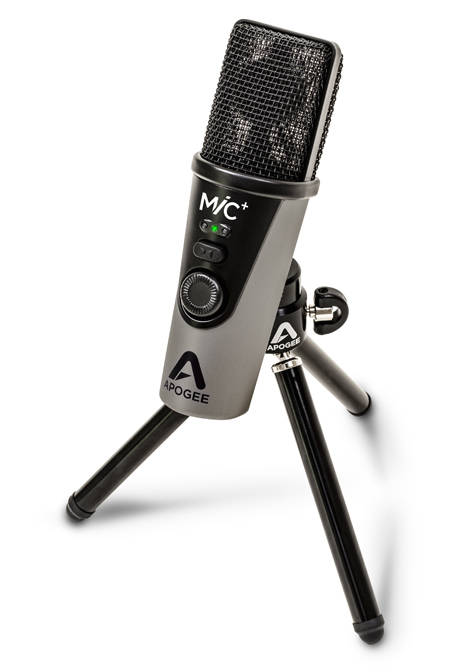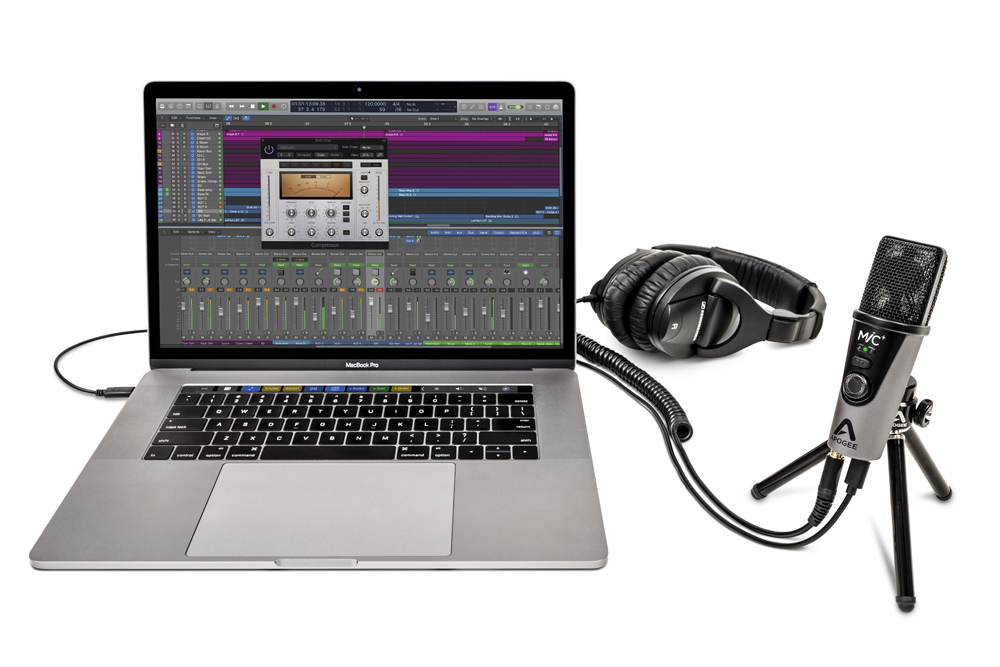New Gear Review: MiC+ by Apogee
Whatever the outcome and historical significance of COVID-19 will turn out to be, March of 2020 marked the month that just about every single profession on earth was thrown into a time of uncertainty and needed to find new ways to adapt.
The music industry was decimated as concert seasons were cancelled and musicians, engineers, technicians, stage hands, and even producers all became unemployed practically overnight. They were soon joined by their colleagues in the service industry as countless bartenders, chefs, hosts, and wait staffs found themselves out of work.
Education has been tasked with continuing as best as possible with remote learning. Spring breaks around the country and around the world were extended as mandated social distancing practices became increasingly widespread, and most institutions have cancelled all live activities and concerts, including graduations, proms and sporting events.
Online lessons and masterclasses have been around for awhile, but many educators, myself included, have avoided the practice until now. Perhaps I’m old school, but I never saw much interest in bringing in a guest artist on a screen through a substandard microphone. I’d always preferred to save my funds to have a real living person in a real acoustic environment.
Speaking of acoustics, my main issue with online education—and particularly online music education—is sound quality. Many of us quickly found that FaceTime, Skype, and Zoom are quite inadequate for serious music making. It’s not totally the software’s fault, as the low fidelity of built-in microphones and speakers on phones and computers plays a huge role in compromised sound quality.
Teachers that are tech savvy and well-equipped can throw all kinds of audio interfaces and premium microphones at the problem, which is what I did myself. But this creates restrictions on movement and adaptability for meetings, virtual lessons, and online classrooms.
Enter the need for a truly portable and versatile solution in the “USB Microphone” category. That need is met handily by the Apogee MiC+. Let’s see what it’s all about.
Features
First, let me explain the idea of a “signal path” to some of the newer readers that might be stumbling across this review.
A high quality audio signal has several stages, and each stage has a profound affect on what is ultimately heard. A USB mic also needs to be not only a microphone, but also a microphone preamplifier and an analog to digital (A/D) converter. Recording studios spend many thousands of dollars to equip themselves with all 3 of these critical components.
Therefore, a portable plug-and-play microphone has to balance the build quality of each stage in the signal chain. One of Apogee’s legacies is their revolutionary A/D conversion. You absolutely hear the difference when the analog signal gets converted into the digital realm at such a high level.
If you are used to large diaphragm studio microphones, the MiC+ box arrives surprisingly small. This is a good thing, as it plays into the incredibly portable nature of this small mic. Opening the box reveals a toolkit of everything you need to enhance your virtual audio experience twenty-fold.
The most amazing thing, especially in this era, is seeing 3 connector cables included in the box! Standard USB, USB-C (Apple Thunderbolt 3), and iOS Lightening cable (iPhone/iPad) are all here. You can physically relax when you see those cables and realize you can plug the MiC+ into anything without dongles, cable hunting, or online shopping. Well done.
In Use
The plug-and-play capabilities of the MiC+ is important for this type of device and user. As a music technology educator, I’ve been asked often about ways to improve sound quality over FaceTime, Skype, or Zoom. A complicated interface and driver setup will not do at all, and Apogee has done a superb job of making this truly “plug and play.”
You can mount the mic on the included desktop tripod or use an included adaptor to mount it on a standard microphone stand. The cardioid pattern of the capsule rejects any sounds not coming from in front of the microphone, and an adjustment knob allows you to easily swivel and position the microphone just like the big ones in broadcast and recording studios.
My first connection was the USB-C (Thunderbolt 3) into a MacBook Pro. Again, it is so relaxing to not have to worry where the stupid dongle is, and to have a rig that is easily portable. Once plugged in, The MiC+ appears instantly in the “Sound” section of your system preferences. No driver, no surrogate app; it truly is a “plug it in and go” scenario.
A quick glance at FaceTime’s “Video” drop down menu showed MiC+ waiting there under both the “Microphone” and “Output” options, alongside the built-in or other audio options. (Note: FaceTime integration is not compatible on iOS devices, more on that later). Zoom is compatible; the menu next to the mic icon automatically shows MiC+ for the “Select a microphone/speaker” list in Zoom conferences.
The MiC+ is everything you need in a compact audio interface. The dial on the front of the mic sets your input level. 3 LEDs that burn green-yellow-red give you a professional level indicator on your voice or any instrument you are using. The sound capture is excellent and your recipients will benefit from the pristine quality of your audio.
The “Blend” feature that offers zero latency monitoring is fantastic. Direct monitoring without that pesky computer “delay” is often tricky to set up. However, the Apogee MiC+ does the routing automatically, and you get broadcast quality monitoring in your headphones with no fuss. The single “Blend” button also allows you to mix (or blend) your direct monitor level with any source material from the phone, iPad, or computer. It is a clever little headphone mix in a clever little microphone.
Speaking of headphones, the headphone jack on the MiC+ is also loaded with professionalism. This is really no surprise on Apogee’s part. Quality audio equipment also requires good D/A converters (digital back to analog), and this headphone output does not disappoint. Long after the conference or lesson is over, you’ll find yourself listening to music or movies in true hi-fi that blows away any phone or computer’s built-in conversion.
Switching the MiC+ over to an iPad or iPhone carries some interesting possibilities. One thing to note is that iOS FaceTime does not work with USB microphones; this is a restriction on Apple’s part as the app only works with hardware that’s been designed for telephony (i.e. a telephone accessory). However, the iPhone/iPad Zoom app does indeed work with the MiC+. So this follows an emerging pattern that Zoom is more effective for lessons than FaceTime.
Where the MiC+ really complements an iPhone or iPad is in the recording department. Any videos you take with the camera are now enhanced with HD broadcast quality sound. Likewise, your iOS recording apps (like GarageBand) are now high quality multitrack studios. You can easily navigate your way to creating great virtual content with minimal effort.
The recorded tracks sound stunning and even “expensive.” You would be hard pressed to guess such a big professional sound came out of such a little all-in-one mic. From a baby grand piano to an acoustic drum set, the microphone handles everything remarkably well, as long as you pay attention to the input meter.
To Be Critical
Perhaps, in the future models, Apogee can consider adding a switchable built-in limiter (like their soft limit feature on their audio interfaces). The dynamic range of this mic is impressive, but that sometimes means you have to constantly adjust levels between loud instruments and speech. I was often tempted to add a software compressor in the signal chain to balance the broadcast. Ultimately, I felt that would take away from the “plug and play” nature of this product and the average user’s context. To that end, Apogee has another USB offering, the HypeMiC, which does feature onboard compression.
It also seems like a fitted windscreen could be included at its price point of $259. This is an ideal outdoor and location solution (sound designers will love it). However, a foam or furry windscreen would really help seal the deal. Admittedly, these critiques are asking Apogee to pack even more pro features into a product/price point that is already high end (literally).
Summing it Up
The Apogee MiC+ is an efficient and compact solution to the many, many woes of built-in mics and speakers. The engineers at Apogee have succeeded in packing high quality circuitry into a little unit that rivals audio interfaces, cables, and microphones costing much more. It is perfect for someone new to outboard technology who wishes to upgrade their broadcast ability in one shot.
Even those who have a bunch of gear available will welcome and find many uses for this simple, compact, and great sounding microphone. The only downside is the recipients on the other end need to have their own MiC+ to complete the virtual experience. With the many uses for this microphone beyond a period of quarantine, maybe picking one up isn’t a bad idea.
Christopher Swist is owner and head engineer at EvenFall Studio LLC in New Hampshire. He is also Resident Artist at Keene State College and teaches Music Technology, Composition, and Percussion.
Please note: When you buy products through links on this page, we may earn an affiliate commission.








